
Angkor, also known as Yasodharapura, was the capital city of the Khmer Empire. The city and empire flourished from approximately the 9th to the 15th centuries. The city houses the Angkor Wat, one of Cambodia's most popular tourist attractions.
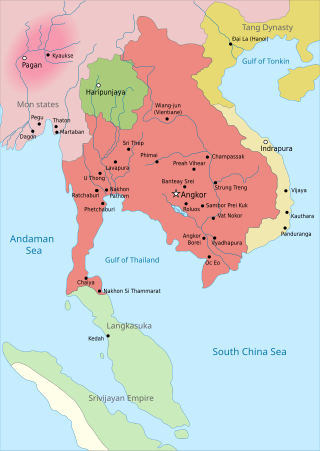
The Khmer Empire was a Hindu-Buddhist empire in Southeast Asia, centered around hydraulic cities in what is now northern Cambodia. Known as Kambuja by its inhabitants, it grew out of the former civilisation of Chenla and lasted from 802 to 1431. Historians call this period of Cambodian history the Angkor period, after the empire's most well-known capital, Angkor. The Khmer Empire ruled or vassalised most of mainland Southeast Asia and stretched as far north as southern China. At its peak, the Empire was larger than the Byzantine Empire, which existed around the same time.

Hinduism in Southeast Asia had a profound impact on the region's cultural development and its history. As the Indic scripts were introduced from India, people of Southeast Asia entered the historical period by producing their earliest inscriptions around the 1st to 5th century CE. Today, Hindus in Southeast Asia are mainly Overseas Indians and Balinese. There are also Javanese and Balamon Cham minority in Cambodia and south central Vietnam who also practice Hinduism.
The early history of Cambodia follows the prehistoric and protohistoric development of Cambodia as a country in mainland Southeast Asia. Thanks to archaeological work carried out since 2009 this can now be traced back to the Neolithic period. As excavation sites have become more numerous and modern dating methods are applied, settlement traces of all stages of human civil development from neolithic hunter-gatherer groups to organized preliterate societies are documented in the region.

Chenla or Zhenla is the Chinese designation for the successor polity of the kingdom of Funan preceding the Khmer Empire that existed from around the late sixth to the early ninth century in Indochina. The name was still used in the 13th century by the Chinese envoy Zhou Daguan, author of The Customs of Cambodia. It appears on the Mao Kun map. However, modern historiography applies the name exclusively to the period from the late 6th to the early ninth century. This period of Cambodian history is known by historians as the Pre-Angkor period. It is doubted whether Chenla ever existed as a unitary kingdom, or if this is a misconception by Chinese chroniclers. Most modern historians assert that "Chenla" was in fact just a series of loose and temporary confederations of principalities in the pre-Angkor period.
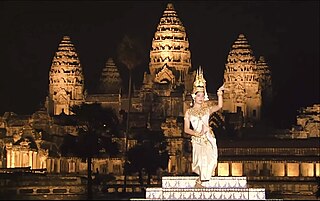
Throughout Cambodia's long history, religion has been a major source of cultural inspiration. Over nearly two millennia, Cambodians have developed a unique Cambodian culture and belief system from the syncreticism of indigenous animistic beliefs and the Indian religions of Buddhism and Hinduism. Cambodia's unparalleled achievements in art, architectures, music, and dance from the 9th and 14th century have had a great influence on many neighboring kingdoms, namely Thailand and Laos. The effect of Khmer culture can still be seen today in those countries, as they share many close characteristics with current-day Cambodia.

The Khmer people are an Austroasiatic ethnic group native to Cambodia. They comprise over 90% of Cambodia's population of 17 million. They speak the Khmer language, which is part of the larger Austroasiatic-language family alongside Mon and Vietnamese.

Hinduism in Thailand is a minority religion followed by 84,400 (0.1%) of the population as of 2020. Despite being a Buddhist-majority nation, Thailand has a very strong Hindu influence. The majority of Thai Hindus reside in Bangkok, Chonburi, and Phuket.

Greater India, also known as the Indian cultural sphere, the Indosphere, or the Indic world, is an area composed of many countries and regions in South and Southeast Asia that were historically influenced by Indian culture, which itself formed from the various distinct indigenous cultures of these regions. Specifically Southeast Asian influence on early India had lasting impacts on the formation of Hinduism and Indian mythology. Hinduism itself formed from various distinct folk religions, which merged during the Vedic and subsequent periods. The term Greater India, as a reference to the Indian cultural sphere, was popularised by a network of Bengali scholars in the 1920s. It is an umbrella term encompassing the Indian subcontinent and surrounding countries, which are culturally linked through a diverse cultural cline. These countries have been transformed to varying degrees by the acceptance and introduction of cultural and institutional elements from each other. Since around 500 BCE, Asia's expanding land and maritime trade had resulted in prolonged socio-economic and cultural stimulation and diffusion of Hindu and Buddhist beliefs into the region's cosmology, in particular in Southeast Asia. In Central Asia, the transmission of ideas was predominantly of a religious nature.
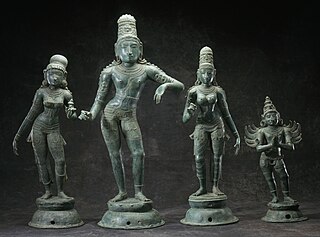
The history of Hinduism covers a wide variety of related religious traditions native to the Indian subcontinent. It overlaps or coincides with the development of religion in the Indian subcontinent since the Iron Age, with some of its traditions tracing back to prehistoric religions such as those of the Bronze Age Indus Valley Civilisation. Hinduism has thus been called the "oldest religion" in the world. Scholars regard Hinduism as a synthesis of various Indian cultures and traditions, with diverse roots and no single founder. This Hindu synthesis emerged after the Vedic period, between c. 500 and 200 BCE and c. 300 CE, in or after the period of the Second Urbanisation, and during the early classical period of Hinduism. It flourished in the medieval period, with the decline of Buddhism in India.

Buddhism in Cambodia or Khmer Buddhism has existed since at least the 5th century. In its earliest form it was a type of Mahāyāna Buddhism. Today, the predominant form of Buddhism in Cambodia is Theravada Buddhism. It is enshrined in the Cambodian constitution as the official religion of the country. Theravada Buddhism has been the Cambodian state religion since the 13th century. As of 2019 it was estimated that 97. 1 percent of the population are Buddhists.
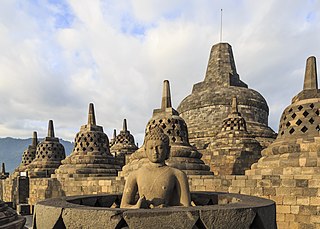
Buddhism in Southeast Asia includes a variety of traditions of Buddhism including two main traditions: Mahāyāna Buddhism and Theravāda Buddhism. Historically, Mahāyāna Buddhism had a prominent position in this region. But in modern times, most countries follow the Theravāda tradition. Southeast Asian countries with a Theravāda Buddhist majority are Thailand, Cambodia, Laos and Myanmar, all mainland countries.

Buddhist art is visual art produced in the context of Buddhism. It includes depictions of Gautama Buddha and other Buddhas and bodhisattvas, notable Buddhist figures both historical and mythical, narrative scenes from their lives, mandalas, and physical objects associated with Buddhist practice, such as vajras, bells, stupas and Buddhist temple architecture. Buddhist art originated in the north of the Indian subcontinent, in modern India, Pakistan and Afghanistan, with the earliest survivals dating from a few centuries after the historical life of Siddhartha Gautama from the 6th to 5th century BCE.
Buddhism is the state religion of Cambodia. Approximately 97% of Cambodia's population follows Theravada Buddhism, with Islam, Christianity, and tribal animism as well as Baha’i faith making up the bulk of the small remainder. The wat and sangha (monkhood), together with essential Buddhist doctrines such as reincarnation and the accumulation of merit, are at the centre of religious life.
Theravada Buddhism is the state religion of Cambodia, which has been present since at least the 5th century.

Khmer sculpture refers to the stone sculpture of the Khmer Empire, which ruled a territory based on modern Cambodia, but rather larger, from the 9th to the 13th century. The most celebrated examples are found in Angkor, which served as the seat of the empire.
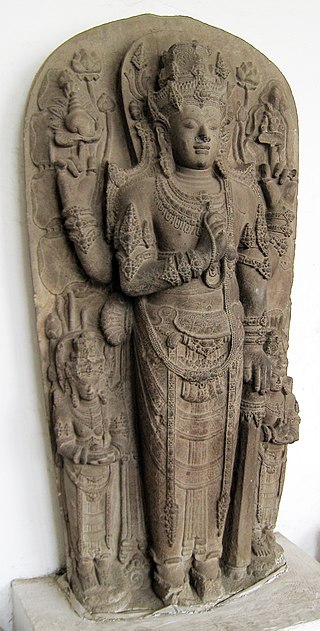
"Devarāja" was a religious order of the "god-king," or deified monarch in medieval Southeast Asia. The devarāja order grew out of both Hinduism and separate local traditions depending on the area. It taught that the king was a divine universal ruler, a manifestation of Bhagawan. The concept viewed the monarch to possess transcendental quality, the king as the living god on earth. The concept is closely related to the Bharati concept of Chakravartin. In politics, it is viewed as the divine justification of a king's rule. The concept was institutionalized and gained its elaborate manifestations in ancient Java and Cambodia, where monuments such as Prambanan and Angkor Wat were erected to celebrate the king's divine rule on earth.

Cambodia–India relations, also known as Cambodian-Indian relations, are the bilateral relations between the Kingdom of Cambodia and the Republic of India. Cambodia has an embassy in New Delhi, and India has an embassy in Phnom Penh.

Southeast Asia was in the Indian sphere of cultural influence from 290 BCE to the 15th century CE, when Hindu-Buddhist influences were incorporated into local political systems. Kingdoms in the southeast coast of the Indian Subcontinent had established trade, cultural and political relations with Southeast Asian kingdoms in Burma, Bhutan, Sri Lanka, Thailand, the Sunda Islands, Malay Peninsula, Philippines, Cambodia, Laos, and Champa. This led to the Indianisation and Sanskritisation of Southeast Asia within the Indosphere, Southeast Asian polities were the Indianised Hindu-Buddhist Mandala.
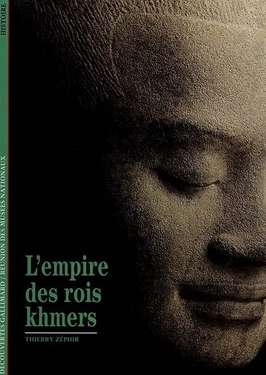
Khmer: The Lost Empire of Cambodia is a 1997 illustrated monograph on the culture and history of Khmer Kingdoms. Written by Thierry Zéphir, a professor of the École du Louvre, and published by Éditions Gallimard as the 310th volume in their "Découvertes" collection, in collaboration with the Réunion des Musées Nationaux.



















